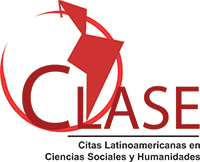COSTOS AMBIENTALES Y CAMBIO TECNOLÓGICO EN MÉXICO (1990-2013)
Abstract
In the canonical version of the Solow growth model (1957), besides the primary inputs (fixed capital and man-hours), in this article we incorporate as negative externalities an estimate the monetary value of environmental damages generated by productive activities, affecting the evolution of technological and operational efficiency of the economy. We take the Mexican economy over the years 1990-2013 as a case study, which allows us to obtain a virtual measurement of technological change net of environmental costs generated by the economy, which in empirical terms constitutes an extended measure of multifactor productivity (MFP). This analysis is carried out at national level, as well as in nine large divisions of the mexican economy. The exercise authorize us to quantify the sectoral effects of the environmental inputs that would have to be paid by productive agents, in order to return to the ecosystem the prevailing conditions at the beginning of each production cycle. We found that in those sectors with decreasing environmental costs per unit of production over time, technological change net of environmental inputs (extended MFP measure) would be noticeably more dynamic than the traditional measurements applied by Solow's canonical model. Conversely, sectors with increasing environmental costs per unit of production would negatively affect the rate of growth of the extended aggregate multifactor productivity measure in the long term, if a "green" path of economic growth is sought.
Downloads
References
Abramovitz, Moses, “Resource and output trends in United States since 1870”, National Bureau Economic Research, no. 46, 1956, pp. 1-23.
Barro, Robert y Xavier Sala-i-Martin, Economic Growth, 2ª ed.,Cambridge MIT press, 2004, p. 660.
Baumol, William y Wallace Oates, Economics, Environmental Policy and the Quality of Life, Engle, Gregg Revivals, Reino Unido, 1993, p. 384.
Becerra, Keitel, Grisel Gómez, y Reyner Reyes, “¿Cómo calcular los costos medioambientales?”, Visión de Futuro, no. 15, julio-diciembre 2011, pp. 68-87.
Bowen, Alex y Tomasz Kozluk, “Long- Term Productivity Growth and the Environment”, OECD Environment Working Papers, OECD Publishing, no. 102, 2016, pp. 1-11.
Brandt, Nicola, Paul Schreyer y Vera Zipperer, "Productivity Measurement with Natural Capital", Society for Economic Measurement Annual Conference, no. 3, 2013, pp. 1-42.
Cammarano, Dario, “Costos Ambientales”, Congresso del Instituto Internazionale di Custos, 2004, p. 4.
Capdevielle, Mario, “Crecimiento y heterogeneidad estructural en México”, documento para ECLAC/BID Project, 2004, p. 56.
Carlaw, Kanneth y Richard Lipsey, “Productivity, technology and economic growth: what is the relationship?” Journal of Economic Surveys, no.17, 3, julio 2003, pp. 457-495.
Ciccone, Antonio y Robert Hall, “Productivity and the density of economic activity”, American Economic Review, no. 86, mayo 1996, pp. 54-70.
Chudnovsky, Daniel, Los límites de la apertura: Liberalización, reestructuración productiva y medio ambiente, Alianza Editorial, Madrid, 1996.
“Comisión Económica para América Látina y el Cáribe, El desempeño mediocre de la productividad laboral en América Latina: Una interpretación neoclásica”, documento de trabajo CEPAL, Santiago de Chile, 2008, p.79.
Coremberg, Ariel, “Natural Resource and Human Capital as Capital Services and its Contribution to Sustainable Development and Productivity KLEMS+N (Natural Capital) Approach ARKLEMS+ LAND”, OECD Environment Working Papers, OECD Publishing,abril 2015, París, pp. 1-76.
De Alba, Edmundo y María Eugenia Reyes, “Valoración económica de los recursos biológicos del país en la diversidad biológica de México 1998”, documento de trabajo, Comisión Nacional para el Conocimiento y Uso de la Biodiversidad, México, 1998, pp. 212-233.
Dosi, Giovanni, “Sources Procedures and Microeconomic Effects of Innovation”, Journal of Economic Literature, no. 26, septiembre1988, pp. 1120-1171.
Frondel, Manuel, Jens Horbach y Klaus Rennings, “End-of-Pipe or Cleaner Production? An Empirical Comparison of Environmental Innovation Decisions Across OECD Countries”, Business strategy and the Environment, no. 16, diciembre 2007, pp. 571-584.
Hernández Laos, Enrique, “Tendencias recientes de la productividad industrial en México”, Investigación Económica UNAM, octubre-diciembre 1991, pp. 11-44.
Hernández Laos, Enrique,“Los costos ambientales en México. Magnitud reciente (1998-1996) y prospectiva (2020)”, Economía: teoría y práctica, julio-diciembre 2001, pp. 63-91.
Hernández Laos, Enrique,“La productividad multifactorial: concepto, medición y significado”, Economía: teoría y práctica, no. 26, enero-junio 2007, pp. 31-67.
Hicks, John, The theory of wages, 2ª ed., Macmillan, Londres, 1932.
Hicks, John, “Thouhts on the Theory of Capital - The Corfu Conference”, Oxford Economic Papers, 13, junio1960, pp. 123-132.
Hottenrott, Hanna, Sascha Rexhäuser y Reinhilde Veugelers, “Climate-related innovations, crowding out and their impact on competitiveness”,Zentrum für Europäische Wirtschaftsforschung (ZEW) policy brief, no. 1, 2014, pp. 20-36.
Hulten, Charles, “Growth Accounting” Handbook of the Economics of Innovation, vol. 2, 2010, pp. 733-1256.
Instituto Nacional de Estadística y Geografía, Sistema de Cuentas Nacionales de México, Cuentas Económicas y Ecológicas de México, 1988-1996, México 2004: http://www.beta.inegi.org.mx/app/biblioteca/ficha.html?upc=702825166083 [consultado 1 de julio 2016].
Instituto Nacional de Estadística y Geografía, Sistema de Cuentas Nacionales de México, Sistema de Cuentas Nacionales de México, Cuentas Económicas y Ecológicas de México, 1997-2003, México 2005: http://www.beta.inegi.org.mx/app/biblioteca/ficha.html?upc=702825169961 [consultado 1 de julio 2016].
Instituto Nacional de Estadística y Geografía, Sistema de Cuentas Nacionales de México, Sistema de Cuentas Nacionales de México, Cuentas Económicas y Ecológicas de México, 2003-2013, México 2013: http://www.beta.inegi.org.mx/app/biblioteca/ficha.html?upc=702825068752 [consultado 1 de julio 2016].
Instituto Nacional de Estadística y Geografía, Sistema de Cuentas Nacionales de México,Sistema de Cuentas Nacionales de México, Cuentas Económicas y Ecológicas de México, Fuentes y metodologías, México 2013: http://internet.contenidos.inegi.org.mx/contenidos/productos//prod_serv/contenidos/espanol/bvinegi/productos/nueva_estruc/promo/SCNM_Metodologia_11.pdf [consultado junio 2016].
Instituto Nacional de Estadística y Geografía, Sistema de Cuentas Nacionales de México, Productividad Total de los Factores, Modelo KLEMS año base 2008, Metodología, 2014: http://www.beta.inegi.org.mx/app/biblioteca/ficha.html?upc=702825068103 [consultado 1 de julio 2016].
Instituto Nacional de Estadística y Geografía,Sistema de Cuentas Nacionales de México, Cuentas Económicas y Ecológicas de México, 2003-2013, México 2015: http://www.beta.inegi.org.mx/app/biblioteca/ficha.html?upc=702825004151 [consultado 1 de julio 2016].
Instituto Nacional de Estadística y Geografía, Sistema de Cuentas Nacionales de México, Productividad Total de los Factores, 1990-2015, México 2015: http://www3.inegi.org.mx/sistemas/tabuladosbasicos/tabniveles.aspx?c=33687 [consultado 1 de julio 2016].
Jorgenson, Dale Weldeau, y Griliches Zvi, “The explanation of productivity change”, Review of Economic Studies, Oxford University, vol. 33, julio 1967, pp. 249-283.
Kendrick, John, “Productivity”, Government in economic life, 1956, pp. 1-52.
Magat, Wesley, “Pollution control and technological advance: A dynamic model of the firm”, Environmental Economic Management, vol. 5, marzo 1978, pp. 1-25.
Obst, Carl, “How the SEEA (System of Enviromental-Economic Accounting Experimental Ecosystem Accounting framework could be used for growth accounting and productivity analysis”, OECD Environment Working Papers, OECD Publishing, no. 102, 2015, pp. 146-192.
Osorio, Juan y Francisco Correa, “Valoración Económica de costos ambientales: Marco conceptual y métodos de estimación”, Semestre Económico de Medellín, vol. 13, enero-junio 2004, pp. 160-192.
Popp, David y Richard Newell, “Where does energy R&D come from? Examining crowding out from energy R&D”, Energy Economics,vol. 34, julio 2012, pp. 980-991.
Porter, Michel y Claas Van der Linde, “Toward a new conception of the environment-competitiveness relationship”, The journal of economic perspectives, vol. 9, 1995, pp. 97-118.
Puig Ventosa, Ignasí., y Jaime Freire, “Efectos de las políticas ambientales sobre la competitividad” Revibec: Revista de la Red Iberoamericana de Economía Ecológica, vol. 6, 2007, pp. 50-73.
Romero, Patricia, Política ambiental mexicana. Distancia entre objetivos y logros, Universidad Autónoma Metropolitana-Xochimilco,México, 2001, p. 290.
“Indicadores de Energía en México: 5 sectores, 5 retos”, Secretaría de Energía y Agencia Internacional de Energía, México, 2011, p. 168.
“Acciones estratégicas para su valoración, preservación y recuperación”Secretaría de Medio Ambiente y Recursos Naturales. Capital natural de México, 2012, p. 165.
Solow, Robert, “A contribution to the theory of Economic Growth”,The Quarterly Journal of Economics, vol. 70, febrero1956,pp. 65-94.
Solow, Robert, “Technical change and the aggregate production function”, The review of Economics and Statistics, vol. 39, agosto 1957, pp. 312-320.
United Nations, Integrated System Environmental and Economic Accounting 2003, Washington, D.C, 2004: https://unstats.un.org/unsd/envaccounting/seea2003.pdf [consultado13 de mayo 2016].
United Nations, Integrated System Environmental and Economic Accounting 2008, Washington, D.C, 2009: https://unstats.un.org/unsd/envaccounting/seeaw/seea2008_w_spa.pdf [consultado 13 de mayo 2016].
United Nations, Integrated System Environmental and Economic Accounting 2012, Washington, D.C, 2014: https://unstats.un.org/unsd/envaccounting/seearev/seea_cf_final_en.pdf [consultado 13 de mayo 2016]
Copyright (c) 2017 Denarius

This work is licensed under a Creative Commons Attribution-NonCommercial-ShareAlike 4.0 International License.














